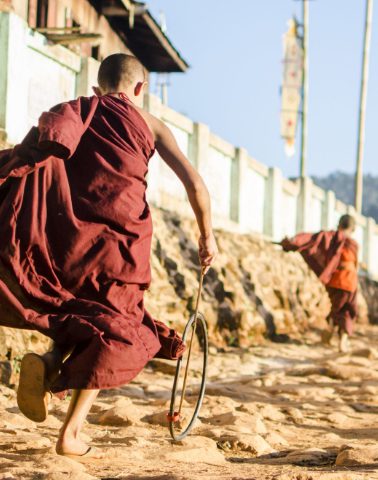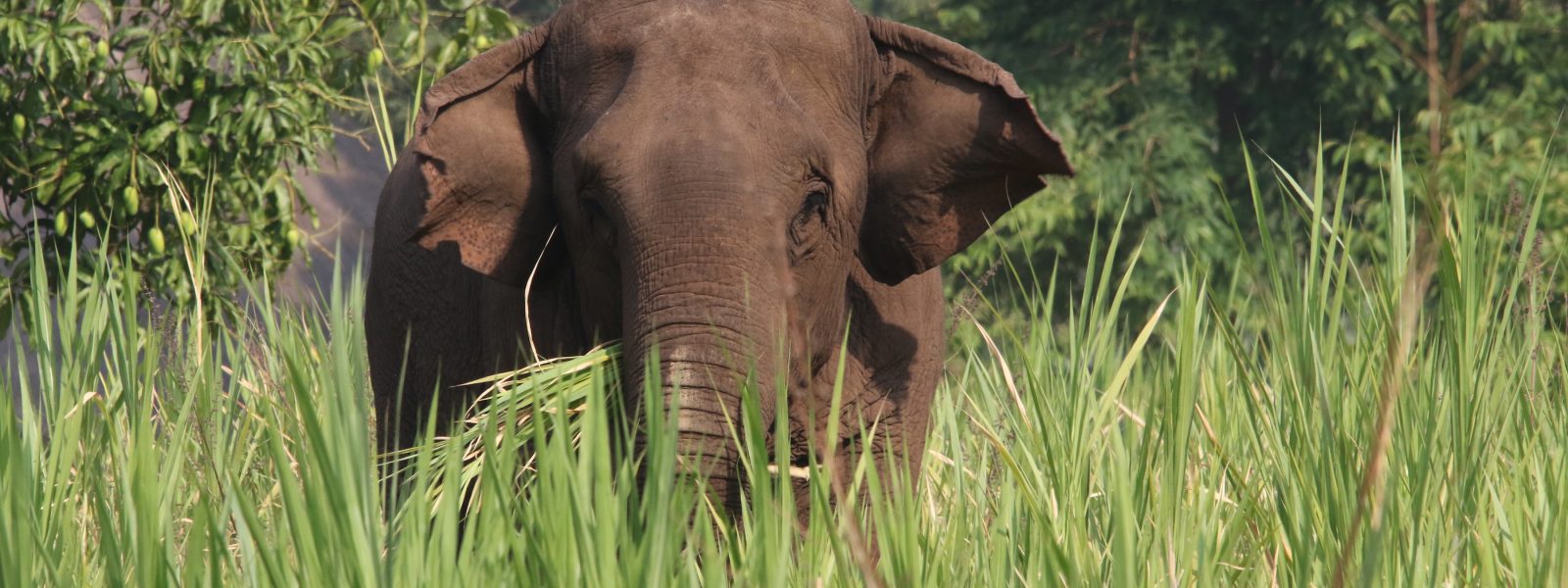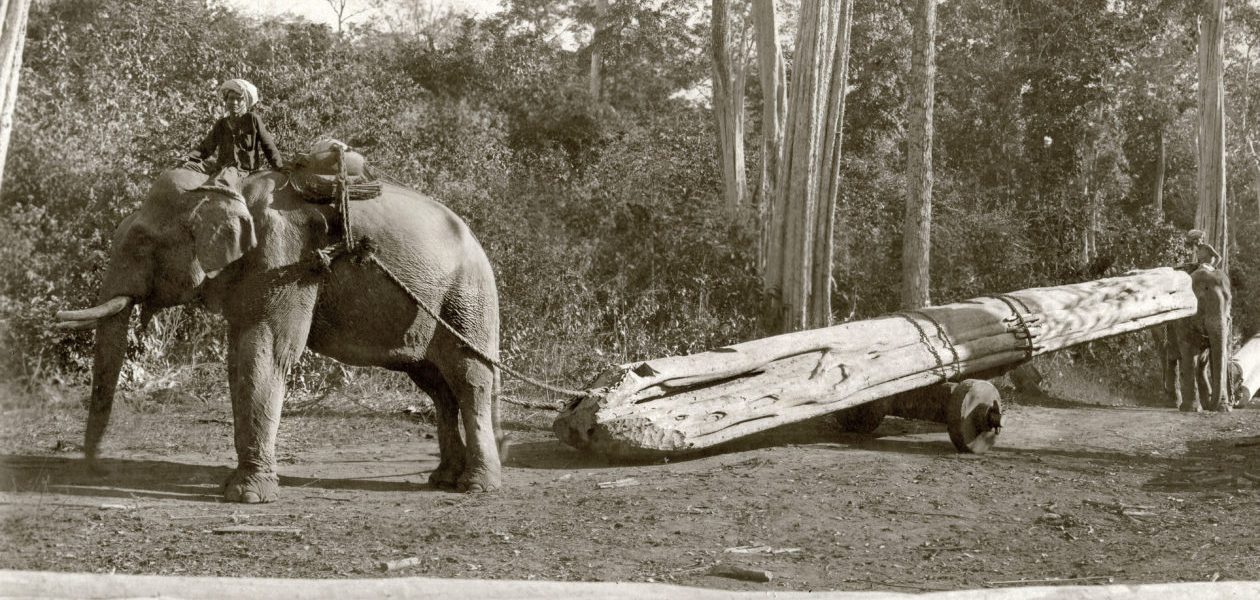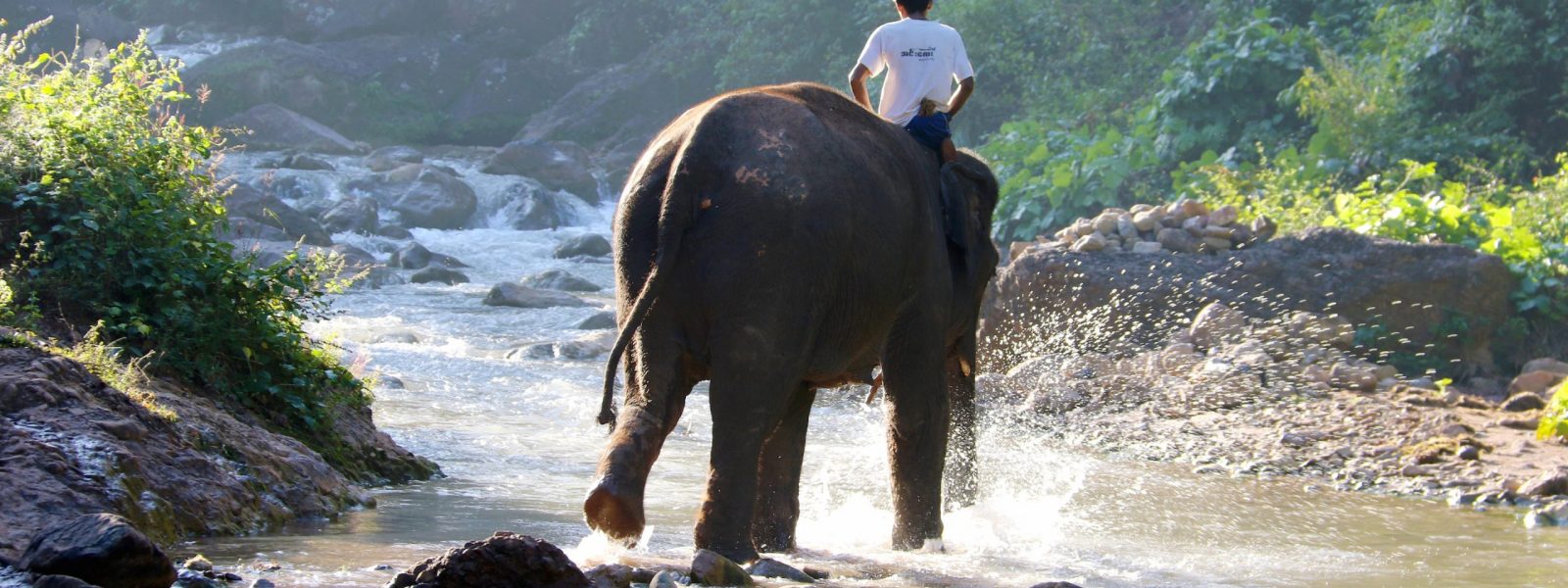
Subscribe to our mailing list
We are still here! Let us send you tips for travelling through Myanmar and stories from the road …
The ethical debate around the elephant tourism industry – and in particular why you should or why you shouldn’t ride elephants – is becoming increasingly pressing in Myanmar.
Over the next couple of years Myanmar is set to open a handful of elephant camps for tourists, offering employment to thousands of elephants and their oozies (the Burmese word for ‘mahout’ or ‘elephant handler’) for whom there is no longer work in the timber industry.
Sampan Travel believes that there are opportunities for tourists to engage positively with elephants and oozies in Myanmar, but it requires both tour operator and traveller to be better informed than has commonly been the case.
Here then, we have put together a brief introduction of the history of elephants in Myanmar, their role in tourism today, and how this may develop in the coming years.

“The Sacred White Elephant was an ill-conditioned beast… and his bad-tempered little eyes were rimmed with red. A hundred soldiers in scarlet and white guarded his Palace, and a row of dancing girls […] were waiting to dance to him after his meal should be finished. Two attendants led him down the line of young mothers. A speckled trunk would come waving out and seize upon the proffered breast, pulling it up and outwards. The women awaiting their turn trembled with eagerness. One woman fell upon the ground in a fit before he reached her, the milk already spurting from her breast, and her lips foaming; her ecstasy had proved too strong.”
So writes F Tennyson Jesse in his book The Lacquer Lady, recounting how women of Mandalay would present lactating bosoms to the Burmese King’s ‘Lord White Elephant’ in the 19th Century, exhibiting just one piece of the long and colourful history of elephants in Myanmar.
In Myanmar, as in neighbouring countries, elephants have long exerted a fascination over the Burmese. For time immemorial these animals have held a special place in Burmese culture, from sacred ceremonies, to battle campaigns, to everyday life, occupying varying positions and at times, as seen above, treated on par with the highest strata of society
When the British annexed Mandalay in 1886, the last Burmese imperial dynasty ended and so shifted the position of the elephant as it became the linchpin of the timber trade, an industry of colossal economic clout.
Yet in addition to their material value, in the eyes of their British owners elephants retained the majestic quality that they had held for centuries in the palaces of Burma. In his story ‘Toomai of the Elephants’, Rudyard Kipling, the bard of the British Empire, portrays elephants as holding the highest position of all the animals in the jungle, describing them as ‘my lords in the chains’.
Kipling also displays the awe in which the relationship between elephant and oozie was regarded. In the same short story, it is a young Indian mahout and not the white Petersen Sahib – ‘the man who caught all the elephants for the government of India’ – who is brought by the great bull Kala Nag into the heart of the jungle to witness the ‘dance of the elephants’.
This haze of myth and legend surrounding the relationship between elephant and oozie crops up time and time again.
In these stories both Kipling and Ghosh celebrate the ancient and hallowed relationship between elephant and oozie; a relationship that may start when both child and calf are but a few years old and can continue through work and play for over sixty years.
In his novel The Glass Palace, the author Amitav Ghosh recounts a ghost story from a camp in British Burma, whereby the death of a young oozie is avenged by his loving elephant, ‘a gentle and good-natured cow by the name of Shwe Doke’. The oozie is pulverised by falling timber when carrying out the orders of an impatient British foreman. That night the ghost of the oozie returns to unchain Shwe Doke who then proceeds to knock the foreman from his veranda and – ‘in a technically perfect execution of the butting manoeuvre of the aunging elephant’ – allows her dying weight to fall upon him.
In these stories both Kipling and Ghosh celebrate the ancient and hallowed relationship between elephant and oozie; a relationship that may start when both child and calf are but a few years old and can continue through work and play for over sixty years.
Many today believe that such a relationship does not exist. It is said that the fabled bond between elephant and oozie – one founded on mutual love and respect – is nothing but a romantic ideal, and if ever a thing did exist it has since been torn asunder by an exploitative and rampant tourism industry.
Across South and Southeast Asia, employment of elephants in the timber trade has dramatically fallen to be replaced by work in tourism. This shift happened in countries such as Thailand a generation ago, but has only recently begun in Myanmar.
In his report from 1997, Gone Astray; The Care and Management of the Asian Elephant in Domesticity, Richard Lair calculates that there were 10, 000 working elephants in Burma leading up to the Second World War. The disruption of war meant that this number was much lower by the time the British left in 1947. It rose through the junta years but never again reached the heights pre-independence.
The Myanmar elephant population is one of the biggest in Asia. Today there are approximately 5,000 registered elephants in Myanmar, the largest population of captive elephants in the world. However work for Myanmar timber elephants has been drying up. In 2016 it was estimated that 40% of the working elephants in Myanmar were unemployed. This figure is expected to be much higher in 2018 now that bans on timber extraction have come into effect across the country. The question of what to do with both elephant and oozie has taken on a new urgency.

Both the Myanma Timber Enterprise and the Myanmar Ministry of Hotels & Tourism have openly cited their desire to put elephant and oozie to work in the tourism industry. While some of the camps scheduled to open refer to themselves as sanctuaries and enforce a ‘no chains, no rides’ policy, others are displaying less wholesome inclinations. In the words of U Tin Kyaw Moe, deputy manager of the Myanma Timber Enterprise extraction department, plans are afoot to ‘train the elephants for entertainment, like in Thailand’.
Elephant camp tourism in Thailand took off in the late 1980s when the country’s timber trade collapsed and mahouts began begging on the city streets, their elephants alongside them. Tourism offered an alternative that was financially sustainable but that did not prioritise the welfare of the animals. Places to ride elephants in Thailand began multiplying rapidly. In these tourism camps the elephants were commonly overworked and poorly treated, kept in conditions far worse than those they had experienced in the timber trade, let alone what they would enjoy in their natural habitat.
In many cases, displays of an elephant performing unnatural behaviour is a sign that it has been taught through a strict and dominant training regime. This is especially the case if the elephant has not been bred in captivity but taken from the wild. Violent training techniques are not required when a calf has grown up in captivity seeing its mother interact harmoniously with her mahout and other humans.
The violent methods sometimes used to train wild elephants derive from a traditional belief that it is possible to drive out the wild instincts of the creature and break its will to resist domination. Young elephants are placed in cramped cages, deprived of food and water and subjected to a sustained barrage of stabbings and beatings until they become suitably pliant to the commands of the mahouts. These training techniques are often erroneously referred to as the ‘phajaan’.*
In 2001, video footage claiming to expose the truth about elephant riding emerged, displaying Thai men and boys putting a young elephant through a torturous ‘training’ procedure. Although the context and validity of the footage has since been called into question, it still had the effect of destroying the reputation of the mahout as having a numinous relationship with his elephant and provoked a backlash as people called for an end to riding elephants in Thailand and a blanket boycott on all elephant camps.
Violent training techniques are not required when a calf has grown up in captivity seeing its mother interact harmoniously with her mahout and other humans.
Activities with elephants were scrapped from many people’s holiday plans and elephant riding in particular began to fade from itineraries and travel brochures. The BBC calculates that a total of 160 travel agencies and tour operators have since ended all promotion of camps that offer elephant rides and shows. In 2016 TripAdvisor announced that it would cease selling tickets to wildlife experiences where tourists came into direct contact with wild animals, including captive elephants.
However a report released last year by World Animal Protection (WAP) indicated that the situation was not improving but in actual fact getting worse. WAP spent two years assessing 220 camps in Thailand, Sri Lanka, Nepal, India, Laos, and Cambodia, and found that 77% of the elephants in these camps were living in ‘severely inadequate conditions’.
And the appetite when in Thailand for elephant rides is not abating. In Thailand alone, the number of elephant camps for tourists has increased by 33% over the last five years. WAP reported that 40% of tourists from the top nationalities visiting Thailand said they had been or were planning to ride an elephant, meaning that elephants in Thailand potentially gave tourists 13 million rides in 2016.

John Roberts, Group Director of Sustainability and Conservation at Minor Hotels, has considered the likelihood of Myanmar following the route that Thailand took. He writes that the people he has spoken to in Myanmar could not conceive of an elephant without a forest, let alone elephants living in the abhorrent conditions of some Thai camps.
Roberts goes on to write:
… but I wasn’t in Thailand in 1989, I suspect the same sentiment prevailed here in those days too and then it only took one businessman to start the rot. The urgency in Myanmar is that while they can’t currently conceive of it their neighbours have already shown it possible and, should a businessman appear before rules are put in place, Thailand has provided a blueprint for lucrative but abusive elephant tourism.
There is already a smattering of elephant camps for tourists in Myanmar. The Green Hill Valley Elephant Camp near Kalaw is set apart from all others. Founded in 2011, this camp for retired timber elephants was set up by a family with a long history of working with elephants. Small groups are welcomed into the camp to hear a history of elephants in Myanmar and learn about the elephants currently in the camp. Each elephant has their own book which visitors can browse through, looking at the scribbled notes from oozies and vets, briefly bathe them in the creek, and feed them copious amounts of pumpkin.
The other camps in Myanmar vary in quality. One that Sampan recommends is Win Ga Baw – just outside of Bago and easy to visit for those staying in Yangon. Win Ga Baw is not perfect but it is attempting to be better. Visitors will not witness elephants playing darts or riding bicycles however circus-esque trickery such as standing on two hind feet with mouths agape to pose for photographs is not uncommon. These performances are principally put on so to please the whims of domestic and regional tourists – a rapidly rising market demographic who do not cringe when they see displays of this nature but in fact are flocking to such shows with gusto.
Elephants are expensive to keep and as work in the timber industry has dried up oozies in Myanmar – as has been the case for mahouts in Thailand – have increasingly become reliant on the worst forms of tourism so to provide for their families and the elephants themselves.
But herein a space opens up for a nuanced response from responsible travel agencies and tourists themselves.
As well-meaning as the call for boycotts may be, it can actually lessen the likelihood of bad practice ending. As Roberts of Minor Hotels argues in another article, if the group of people who ten years ago would have visited an elephant camp with the knowledge to spot abusive behaviour are now not visiting these camps at all, then this group will cease to be a market demographic that warrants consideration, and the management of these camps will instead cater to travellers who are not attuned to the signs of abusive treatment.
Informed and engaged tour operators and travellers are the key.
ABTA have published guidelines for tour operators assessing elephant camps and TripAdvisor have created some for visitors themselves asking should I ride elephants? Drawing off these and additional research, Sampan Travel has also created their own guidelines for travellers visiting elephant camps in Myanmar and are currently working with the sustainable tourism certification body Travelife to assess these camps.
By informing ourselves, we are able to encourage elephant camps to practice a sustainable form of elephant tourism and support those places that are, as WAP puts it, ‘beacons of hope that can encourage the urgently-needed shift in the captive elephant tourism industry’; camps where tourists can ‘watch elephants being elephants’.
The oozies of Myanmar have been referred to as ‘the best trained and most skilled mahouts in the world’, the isolation of the country ensuring that the traditional skills and knowledge that have been lost elsewhere are here alive and well in a ‘living museum’.
One only need take a cursory glance at the history of Myanmar to see what a pivotal place elephants have played in the country’s culture. As Jesse, Kipling, and Ghosh each show, the shifting position of the elephant in Myanmar society is a fascinating one, and the relationship to man something worth treasuring. If high standards can be demanded by informed and engaged tour operators and travellers, then there is a place for elephants in responsible tourism, where the welfare of the elephants is at the forefront, and where education, not entertainment, is supreme.

Notes
*‘Phajaan’ is in fact an ancient religious ceremony traditionally formed in the Lanna regions of Northern Thailand. Before any training of the calf has taken place, the phajaan ceremony calls upon the blessing of spirits for the good of mother, calf, and mahout, at the moment when the calf will begin work for the first time and thus be separated from its mother. It does not necessitate any violence towards the calf.
Resources & Further Reading
Elephant Bill, J. H. Williams
Gone Astray – The Care and Management of the Asian Elephant in Domesticity, by Richard C. Lair
Addressing a Giant Problem in Southeast Asia, ACEWG
Myanmar Timber Elephant Project
Burma Report, Ele Aid
Taken for a ride: The conditions for elephants used in tourism in Asia, World Animal Protection
Elephant Tourism is ‘fuelling cruelty’, BBC
Commitment to Improve Wildlife Welfare Standards, TripAdvisor
Unemployed, Myanmar’s Elephants Grow Antsy, and Heavier, The New York Times
Timber Elephants turn to Tourism, The Myanmar Times
Travellers attracted to elephant based tourism centres, The Myanmar Times
Elephant Tourism: The Harms of Received Wisdom, John Roberts
Thailand’s ‘Elephant People’ Fight Back, Wassana Chailert
Schooling Rituals for Elephant Calves, The Mahout & Thai Elephant Development Education College, the National Elephant Institution, and the Forest Industry Organisation.
Global Welfare Guidance for Animals in Tourism, ABTA
How to be a Responsible Traveler when Visiting an Elephant Attraction in the Asia Pacific Region, TripAdvisor
To Ride or Not to Ride an Elephant in Thailand, Luxe Adventure Traveler